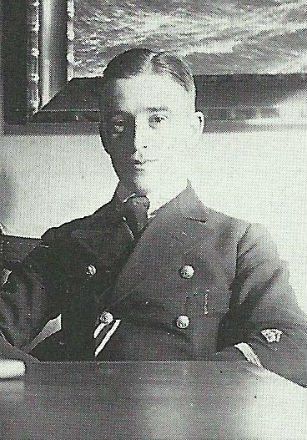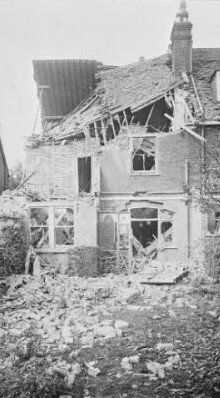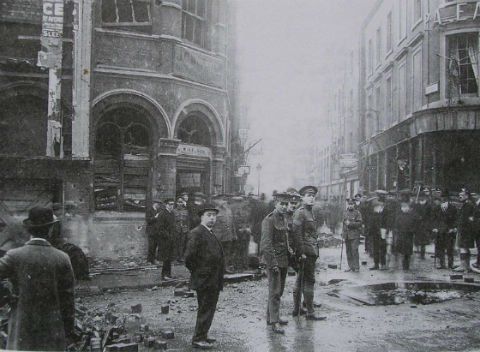13/14 Oct. 1915
Bombed:
Norfolk, Suffolk, Herts., London, Surrey, Kent & Sussex
This was by far the most ambitious raid so far, with five Navy Zeppelins - L 13, L 14, L 15, L 16 and L 11 - intending to strike against London. The first four came inland over Norfolk more or less together with L.11 some distance behind. The raiders met a marked improvement in the gunnery defence of the capital following the recent appointment of Admiral Sir Percy Scott as London’s artillery commander.
Heinrich Mathy, commanding L 13, came inland at about 6.15pm. She passed Dereham, Newmarket and Hertford then, just after 9.00pm, a 13-pdr gun at Birchwood Farm, a mile north-west of Hatfield opened fire. In reply, L 13 dropped four high explosive (HE) bombs. One landed 70 yards from the gun but only damaged windows in nearby cottages. She continued on her course, passing around the west of London and crossing the Thames at Weybridge at 9.50pm. She headed west towards Guildford and came inder fire from a 1-pdr gun at the Chilworth gunpowder mill. L 13 passed over Guildford then turned back and dropped 12 HE bombs over the St. Catherine’s area. These damaged railway tracks, caused damage to a number of properties - particularly in Guildown Road and Chestnut Avenue - killed a swan on the River Wey and 17 chickens.
Mathy followed an easterly course away from Guildford, again passing over Chilworth, and came perilously close to colliding with L 14 between Bromley and Bickley at about 11.30pm.
At 11.45pm, guns at Blackheath and Honor Oak opened fire as L 13 approached Woolwich. She dropped three HE and 14 incendiary bombs on the artillery barracks, injuring four men, killing a horse and injuring nine others in a stable. Another nine incendiaries landed in the town then, over the Arsenal, L 13 dropped one HE and five incendiary bombs, injuring nine men, one of whom later died. A final HE bomb fell harmlessly on Plumstead marshes.
Anti-aircraft guns of various calibres engaged L 13 on a number of occasions before she passed out to sea near Dunwich, Suffolk, at about 2.00am.
Zeppelin L 14, commanded by Kapitänleutnant Alois Böcker, came inland near Bacton, Norfolk, around 6.30pm and eventually crossed the Thames estuary near the Isle of Sheppey. After meandering over Kent, she found herself over the army camp at Otterpool, close to Lympne, at about 9.15pm. She dropped four HE bombs: 8th Howitzer Brigade listed two killed and four injured and 5th Brigade, Canadian Field Artillery, listed 13 killed and seven injured. L 14 continued towards Westenhanger Camp, releasing two more bombs but these landed on the racecourse before she reached the camp.
Having realised he was near the south coast, Böcker turned north, dropping seven incendiary bombs at Frant at 10.30pm, without damage. Ten minutes later, over Tunbridge Wells, Böcker released three HE bombs, smashing a number of windows. L 14 approached East Croydon and at 11.20pm commenced dropping 17 HE bombs between Edridge Road and Howard Road. They killed three brothers in Beech House Road, three died in Oval Road, and three in Stretton Road. Fifteen others were injured.
L 14 almost collided with L 13 between Bromley and Bickley at about 11.30pm before crossing the Thames between Erith and Purfleet where she was engaged by anti-aircraft fire. Other guns also fired parting shots before she finally went out to sea north of Aldeburgh at about 1.45am.
Oberleutnant zur See Werner Peterson brought L 16 inland near Bacton at about 6.40pm, ten minutes behind L 14 and L 15; she was the Navy’s latest Zeppelin, commissioned only 19 days earlier. Ten minutes later, Peterson dropped a high explosive (HE) bomb at Banningham, which caused no damage. L 16 then followed a slightly erratic course southwards. Near Chelmsford, she came under fire from a maxim gun and at Kelvedon Hatch, at about 9.30pm, a 1-pdr pom-pom convinced Peterson to turn away from London. Steering north, he appeared near Sawbridgeworth at about 9.45pm from where he saw lights about 10 miles off. These were reputedly showing from the hospital and the factory of G. Garratt and Sons in Hertford. Arriving over that town at about 10.00pm, L 16 dropped 14 HE and 30 incendiaries. The incendiaries landed in four clusters: seven in or near Hartham recreation ground, 12 around the Old Cross area, six in a garden on North Road and the last four in other gardens on North Road. The first nine HE bombs landed, well spread, between the Folly and North Road. One, which landed outside the Conservative Club in Bull Plain, killed five and wounded four, and at No. 37 killed a child. Bombs in North Road killed two men, both labourers, outside Garratt’s Mill, and also Bombardier Arthur Cox, 2/1st Norfolk Battery, Royal Field Artillery, not far from St. Andrew’s church. The last five HE bombs landed in a group, on Welch’s Meadow and close to the hospital. Total casualties in the town amounted to nine killed and 15 injured. In addition, ten buildings suffered considerable damage and 141 lesser damage.
Peterson then set course for home, crossing the coast near Mundesley at about 12.05am, seemingly believing the River Lea at Hertford was the Thames and he had bombed London.
Commanded by Oberleutnant zur See Horst Freiherr Treusch von Buttlar-Brandenfels, L 11 was the last of the raiders to come inland, arriving over the coast near Bacton at about 8.25pm. She followed a south-west course and twenty minutes later arrived over Coltishall. There, L 11 dropped nine HE bombs, two of which failed to explode. The other seven detonated in open fields between Coltishall and Great Hautbois, not far from Coltishall station. The only recorded damage was ‘a tin shed partly blown down and a few panes of glass broken’. L 11 also dropped seven incendiary bombs close by which landed near a group of three cottages, but buckets of water quickly applied served to extinguish them. Over Horstead, L 11 dropped four more HE and three incendiary bombs, which all fell in open fields resulting in just seven broken panes of glass.
L 11 then continued towards Wroxham where she may have picked up the railway line to Norwich, because as she approached that city at about 9.00pm, a Royal Horse Artillery 15-pdr at Mousehold Heath fired two rounds, convincing her commander to turn east and head towards the coast. She went out to sea near Great Yarmouth at about 9.15pm.
von Buttlar-Brandenfels commanded L.11 when it bombed Norfolk on the night of 13 October
From a German point of view, the most successful raider that night was Zeppelin L 15 commanded by Kapitänleutnant Joachim Breithaupt. She came inland near Bacton at about 6.25pm and passed Thetford, Bury St. Edmonds, Halstead and Braintree before heading west towards Harlow. At 8.40pm at Broxbourne, south of Hertford, a 13-pdr mobile anti-aircraft gun positioned in Church Fields opened fire with nine rounds. In response, L 15 dropped four high-explosive (HE) bombs, one failed to detonate but the other three landed in close proximity to the gun. The blast blew the gunners off their feet and wrecked a wooden shed as well as a lorry and a car belonging to the detachment.
L 15 was seen passing Edgware at 9.03pm but was not observed again until it appeared over Westminster and was engaged by the Green Park anti-aircraft gun moments before 9.30pm. Then, five minutes later, Breithaupt began dropping bombs in Covent Garden, in the heart of London’s theatre district. The second HE bomb landed in the road at the corner of Wellington and Exeter Streets, between the Lyceum theatre and the offices of the ‘Morning Post’ newspaper; it killed 17 and injured 21. Other bombs killed three people in Aldwych and injured 15. Turning north, bombs dropped on Gray’s Inn and Lincoln’s Inn, two of London’s four Inns of Court. One bomb smashed the 17th century stained-glass window of Lincoln’s Inn Chapel. Another bomb exploded in Chancery Lane, damaging the roadway, while incendiary bombs caused damage around Hatton Garden and Farringdon Road.
No more bombs dropped until L 15 was over Finsbury Pavement, where she came under fire from a new 75mm auto-cannon recently arrived from France. Two bombs in Finsbury Pavement killed four and injured ten. In Aldgate, a bomb hit a hotel in the Minories and damaged nearby buildings, killing one and injuring eight. Ten minutes after the first bomb, L 15 released her final four London bombs; two fell close to the Royal Mint and two just north of the Western Docks, but damage was limited to a number of tenement houses, while six people were injured. Then L 15 climbed higher to avoid the increasing gunfire she encountered and took a northerly course out of London.
A number of guns fired at L 15 as she headed back to the coast including a RNAS 1-pdr pom-pom at Rushmere Heath, near Ipswich. In reply, L 15 dropped four HE bombs but these caused no damage: one landed on a golf course, one in a potato field and two in a turnip field. L 15 crossed the coast near Aldeburgh at about 11.55pm.
Despite much ground fog that night, the RFC got five aircraft up, however, only one saw a Zeppelin, losing it in cloud. Three of the pilots damaged their aircraft when attempting to land at fog-bound airfields.
Casualties: 71 killed, 128 injured
Damage: £80, 020


